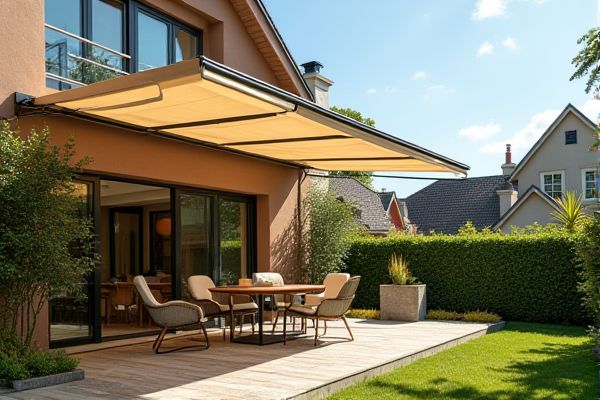
Retractable awnings offer flexibility by allowing you to adjust shade and protect your outdoor space only when needed, while fixed awnings provide permanent protection and enhanced durability against weather elements. Explore the article to discover which awning type best suits your lifestyle and outdoor needs.
Table of Comparison
| Feature | Retractable Awning | Fixed Awning |
|---|---|---|
| Adjustability | Can extend or retract as needed | Permanent, fixed position |
| Sun Protection | Flexible; can be adjusted for optimal shade | Consistent, always provides shade |
| Durability | Moderate; moving parts may require maintenance | High; solid structure withstands elements |
| Installation | More complex; requires mounting hardware | Simple; fixed to wall or frame |
| Cost | Higher initial cost due tomechanism | Generally lower cost |
| Space Usage | Saves space when retracted | Occupies permanent space |
| Maintenance | Requires regular upkeep of retractable mechanism | Minimal maintenance required |
| Lifespan | 5-10 years depending on use and care | 10-15 years with proper maintenance |
Introduction to Retractable vs Fixed Awnings
Retractable awnings offer flexibility by allowing users to extend or retract the canopy based on weather conditions, enhancing outdoor comfort and protection. Fixed awnings provide a permanent, sturdy shelter that requires minimal maintenance and is ideal for consistent shade and weather protection. Choosing between retractable and fixed awnings depends on factors such as climate, usage frequency, and aesthetic preference.
Key Features of Retractable Awnings
Retractable awnings offer adjustable coverage with a flexible design that extends or retracts according to weather conditions, providing optimal sun protection and energy efficiency. These awnings typically feature motorized or manual operation, durable weather-resistant fabrics, and compact storage when retracted, reducing wear and extending lifespan. Key advantages include customizable shade control, enhanced outdoor living comfort, and protection against UV rays and rain, making them a versatile option compared to fixed awnings.
Key Features of Fixed Awnings
Fixed awnings offer robust, permanent coverage with durable materials designed to withstand harsh weather conditions, providing consistent shade and protection for windows, doors, and patios. Their solid frame and fixed installation ensure low maintenance and enhanced stability compared to retractable models. Fixed awnings also come in a variety of styles and fabrics, allowing customization for architectural aesthetics and UV protection.
Durability and Weather Resistance Comparison
Retractable awnings offer flexible protection by allowing users to extend or retract the canopy, shielding against sun, rain, and wind damage when needed, which enhances longevity. Fixed awnings, constructed with robust frames and durable fabrics like acrylic or aluminum, provide constant coverage but may be more susceptible to wear from prolonged exposure to harsh weather conditions. Choosing between retractable and fixed awnings depends on the balance between desired durability, weather resistance, and maintenance preferences for optimal lifespan.
Installation Process: Retractable vs Fixed Awnings
Retractable awnings require a more complex installation process involving durable mounting brackets and motorized or manual mechanisms to ensure smooth extension and retraction, often necessitating professional assistance. Fixed awnings have a simpler installation, typically mounted securely to the building facade with fewer mechanical components, allowing for quicker and more straightforward setup. Properly installed retractable awnings offer flexibility and space-saving benefits, while fixed awnings provide long-lasting, maintenance-free shade solutions.
Maintenance Requirements for Both Types
Retractable awnings require regular inspections of mechanical components, such as motors and folding arms, to ensure smooth operation and prevent wear or rust. Fixed awnings demand less frequent maintenance but need periodic cleaning of fabric and frame to avoid mildew, dirt buildup, and corrosion. Both types benefit from seasonal checks, though retractable models often incur higher maintenance costs due to their complex moving parts.
Cost Analysis: Upfront and Long-Term Expenses
Retractable awnings generally have higher upfront costs due to complex mechanisms and motorized options but offer long-term savings through reduced maintenance and energy efficiency. Fixed awnings require lower initial investment but may incur higher expenses over time because of weather-related wear and lack of adjustability, leading to potential replacement or repair. Considering the balance between initial price and durability is crucial for cost-effective awning selection.
Aesthetic and Design Options
Retractable awnings offer versatile aesthetic and design options with customizable fabrics, colors, and patterns that adapt to changing outdoor decor, enhancing your home's curb appeal. Fixed awnings provide a more permanent structure with a solid frame and durable materials, often complementing traditional architectural styles for a classic look. Your choice depends on whether you prefer flexible style updates or a consistent, long-lasting design.
Best Use Cases for Each Awning Type
Retractable awnings offer flexible shade solutions ideal for patios and decks where you want control over sun exposure, allowing you to extend or retract the fabric as needed throughout the day. Fixed awnings provide a durable, permanent cover perfect for windows and doorways that require consistent protection from sun and rain without adjustments. Your choice depends on whether you prioritize adaptability with retractable models or long-term stability with fixed awnings for your outdoor space.
Which Awning Should You Choose?
Choosing between a retractable awning and a fixed awning depends on your outdoor space needs and climate control preferences. Retractable awnings offer flexibility, allowing you to extend or retract the cover to enjoy sunshine or shade, which is ideal for variable weather conditions and maximizing your outdoor comfort. Fixed awnings provide permanent shade and protection from rain, making them a durable, low-maintenance option for consistent coverage.
 homyna.com
homyna.com